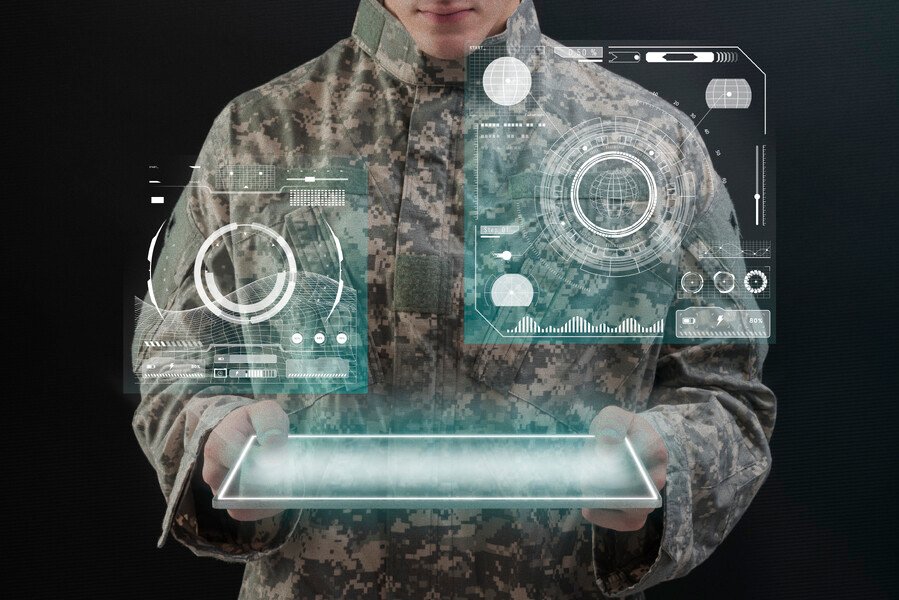AI Application in Military – Part II: AI and its military applications are a dynamically evolving field. AI systems are designed for a purpose which can be singular or multiple, simpler or extremely complex and can be used for all three levels of warfare; strategic, operational and tactical. It can be coupled with human-in-the-loop or made completely autonomous. This article AI Application in Military – Part II will focus on approach to AI application in military.
AI Application in Military: Autonomy of Systems
Machines that operate for a set duration, pause for human input, are often called semiautonomous or human-in-the-loop systems. Those capable of independent operation but monitored by humans, ready to intervene if issues arise, are referred to as human supervised autonomous or human-on-the-loop systems. Fully autonomous machines that operate independently with no human intervention are termed fully autonomous or human out-of-the-loop systems.
AI Application in Military: Debate in AI Approach
Most nations having capacity to do so will design or obtain AI enabled systems. The fundamental question is the core principles and building blocks for implementing AI.
George Galdorisi from Naval Information Warfare Center, Pacific and Dr. Sam Tangredi from
U.S. Naval War College note that the major military powers—Russia, China, and the U.S.—recognize the potential of big data, artificial intelligence, and machine learning in military applications.
However, they diverge in their approaches to its development. Such as government policy and involvement, R&D, risk tolerance, autonomy delegation to AI systems, application priorities, control regimes and domains of applicability.
Apart from policy implications, there is also a conflict in terms of views and perspectives specially when an approach to AI application in military is under question. For instance user may have confidence issues.
Yes AI is promising and its application has been demonstrated successfully in multiple military capabilities. However, it is still evolving. Mass productions and fielding of systems will require certain assurance.
With high paced technological evolution in AI as well as the technologies that enable it. It becomes difficult to have a clear foresight of requirements. More importantly people are yet trying to grasp the magnitude of possibilities as well as risks of AI and autonomy.
Another aspect is the algorithm. Can elements of human intelligence such as cognition, judgement, reasoning, inference, intuition be replicated. Can the system algorithm be designed to ensure right limits at right times all the time. More so can it be trusted to perform in accordance with limitations imposed.
Greater resistance exists on the question of amount of autonomy that should be delegated to an AI system designed for military purposes. As focus remains on capability and lethality aspects rather than what the system is designed to do. Therefore, AI with autonomy rings alarm bells in policy circles. While analysts have proposed ‘applying the right amount of AI, at the right place, at the right time’.
It is easier said than done. What is the right amount of AI for a system. This decision will depend on many factors such as amount of data to be processed, speed at which decisions are required to be undertaken and response time available. AI and automation can be extensively useful for instance in detection of cyber security threats and response. However, in a friend or foe situation such as counter terrorism operations in urban areas may present an environment where dependence on AI autonomous systems may present challenges.
Therefore, rather than perceiving autonomy as an inherent characteristic of standalone systems, it holds greater significance to evaluate the design and functioning of systems within the context of human-system collaboration.
In addition, the acquisition of AI systems is also an important consideration. Designing and training an AI system is complex task requiring certain expertise. Every country or organization may not have the capacity to develop AI systems. Their proliferation though will occur. AI systems are difficult to design, however, they are much easier to operate in comparison. Therefore, most countries will rely on acquiring AI enabled systems rather than designing them.
This brings forth the requirement and challenges in control regimes. Chip War between U.S. and China within the ambit of ‘new cold war’ is indicative that AI will be a contested area. AI superpowers are likely to make every effort to shape the future of AI and its application. It is yet to be seen whether these powers will come together to limit the scope and proliferation of this technology in military domain like it happened in case of nuclear weapons and delivery systems.
‘Buyer militaries’, which will be a majority, will have to strategize AI systems acquisitions. More importantly in such a scenario risk of back doors and espionage exists and will have to be weighed. Trusted dependence is therefore more likely to emerge. Nevertheless, geopolitics will enhance or limit the possibilities of capability acquisitions. Multipolarity will be advantageous and much desired.
Finally, the cost of such system will have to be considered against the benefits. For example in case of smaller but wealthy countries such as Singapore or the United Arab Emirates, AI solves one of their major problems; lack of human resource. Therefore, AI military systems regardless of their costs may present greater advantages to make good the lack of numbers. However, for many others cost-benefit analysis may not be a straightforward undertaking.
AI Application in Military: Admin-Operations Model
Militaries are required to undertake plethora of roles and tasks such as benign, military or diplomatic etc. Forces often operate in widely dispersed areas at long distances. Operate crewed and autonomous systems in the air, surface and underwater. No matter where forces operate, all forces have a home; administrative set ups, bases, maintenance, stores, rations, training, medical facilities and so on.
Admin-Operations Model bifurcates the development and integration thrust in two basic lines of approach. Administrative and Operations.
First step is to bifurcate all matters into administrative and operational lines. For instance, preparing budget plans is an administrative task. Operational logistics on the other hand is related to operations.
Step two is to identify all interlinkages between administrative and operational matters. For example, relationship of military hospitals and field hospitals or medical ship. Similarly, refining just in time (JIT) training requirements against dynamic and emerging field realities such as in counter terrorism operations environment.
Step three is E2I3 (Evaluate, Investigate, Experiment, Implement, Integrate).
(1) Evaluation requires contemplating on AI requirements for both administrative and operational functions. Here the application must comply with the basic requirement of right amount of AI, at the right place, at the right time.
For example, evaluating an AI requirement for cyber warfare. It will be benefitted with considerable AI application utilizing different and hybrid solutions to thwart cyber threats. In terms of place, at the minimum their requirement will exist in nodes and hubs as well as dispersed locations where forces may be stationed or operate. In terms of time, they will be required 24/7 to monitor, evaluate, warn and respond to cyber anomalies.
(2) Investigation will involve scrutiny of type of AI model and architecture that best suits the administrative or operational requirement. Here, it is important to undertake an in-depth analysis of available models and architectures. AI is an evolving field. A lot is yet to be discovered and much optimization is pending or ongoing in existing systems.
Based on the nature and sensitivity of administrative or operational task and threats such as cyberattacks, targeted espionage or disruption activity; security classification will need to be gauged. All AI models may not be secure to use in military applications.
As long as in-house design, development, fabrication and testing of electronics is not assured, back doors should always be expected. Therefore, what systems can be trusted for use and the decision to the sensitivity of task that can be interested to such systems need to be well deliberated.
In this phase free exchange of information and ideas between user and developers is essential to stream line end product in the most efficient manner.
(3) Nvidia was the first company that made Graphics Processing Units (GPUs). When Nvidia was formed, Intel and AMD dominated PC chip business based on x86 architecture. Nvidia therefore targeted graphics market and their initial customer base was a small but budding gaming industry. Nvidia made processor that involved parallel computing that enabled the greater resolution and picture quality while ensuring that system functioned smoothly with sufficient computing power. This microprocessor when designed did not have the slightest of idea about its utility in AI until researchers at MIT used these chips for training AI models with resounding success. GPUs are now fundamental for AI systems because of parallel computing technology.
Experimentation therefore will be essential. By experimentation here it does not imply R&D alone. It also implies that the organization should remain cognizant of transitionary and evolving nature of AI systems as well as duality of COTS technology. Therefore, it must maintain sufficient leverage for experimentation, trials and testing prior fielding systems in mass.
(4) Implementation phase will involve implementing AI models and architectures to develop individual systems or subsystems in a larger application. Phase wise implementation will be essential for four reasons.
First, development of individual systems separately will enable availability of multiple systems for use in their individual capacities augmenting administrative and operational functions.
Second, is the evolution of systems and their maturity. While systems are employed after thorough testing and evaluation of performance. However, actual environment always presents its unique challenges. It will be imperative to let AI enabled systems to refine and mature in actual operational environments. It is also essential specially for human in the loop systems to allow margins for human development for thorough understanding and honing of abilities to exploit all functionalities of AI systems to the fullest extent.
Third, it will allow refinements in requirement of right amount of AI, at the right place, at the right time. Here desirability will be maintained, curtailed or enhanced by possibility. Because in the evaluation and experimentation phase practical manifestation cannot be gauged to higher degree of accuracy. It is only in the practical implementation and utility when many other factors will come into play such as hostile action against the system. Therefore, higher degree of evaluation will be possible and greater confidence levels can be achieved. In other words, phase wise implementation will augment evaluation phase.
Fourth is the allowance for experience gained, lessons learnt and feedback mechanism for AI system’s algorithm finetuning and dataset refinements for maximized efficiency.
(5) Phase wise development and implementation will allow subsequent integration of systems and subsystems to become system of systems. It is the phase where existing AI systems can be integrated to enhance the overall scope, complexity and reliance. It is also a phase where larger complex systems will be possible with higher degree of well calibrated autonomy, minimizing human requirements yet maintaining freedom of intervention where required.
Integration will also augment performance of individual systems and subsystems where larger dataset through differing sources will be available for utility by various individual AI models and architectures used in individual systems or subsystems integrated within a larger network.
In Conclusion
AI will revolutionize military affairs to a greater extent. It is already transforming battle fields in Nagorno Karabakh and Ukraine. The scope, potential, opportunity as well as threats are consequential and require attention of all modernistic future looking forces. Admin-Operations model provides a suitable approach to AI application in military.






